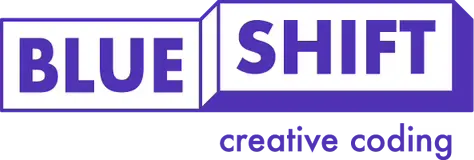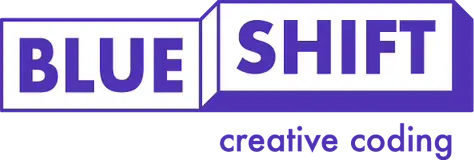Coding and the arts
It’s a common misconception that coding is a purely scientific, mathematical skill, with no place in the arts. Some people even assume that they or their child wouldn’t enjoy coding, since they’re more interested in arts than sciences or maths.
Here at BlueShift we like to challenge these ideas; we think coding is highly creative, and combines the skills used in arts, sciences and maths, making it the perfect complement to children’s school studies and potentially an enjoyable future career. You might be wondering what exactly we mean by this; how is coding creative?
Coding is essentially creative problem solving. Coders are presented with a problem, and no fixed way of solving it, so they have to get creative! Not only do they use their creativity when deciding how to approach the problem, they also have to flex their creative muscles to work out how to solve it given particular constraints. They have to work within the constraints of the logic that the computer understands. This means using programming languages, but these languages only have a certain number of words. This forces coders to be even more creative: you can’t just tell a computer what it needs to do as though you were talking to a colleague! Coders have to think creatively about how to apply their limited resources to create a solution to the problem they are presented with.
So all coding is creative. But what if we told you that for some people coding is an art in itself? We spoke to some of the talented BlueShift teachers who are using code as part of their art practice.
When he’s not teaching, BlueShift teacher Daniel Evan’s is a musician. We spoke to him about how he uses coding as part of his art.
Hey Daniel, tell us about your art!
I make music under various names and with various groups. My solo electronic (and computational) music project is under the name ‘peb’ and uses code and synthesis processes to explore historical pitches, psychoacoustics and algorithmic rhythm generation.
How do you use coding as part of this?
I started coding because of music. I had an intense interest in lots of computer/electronic music which required me to learn a lot of coding skills for myself. I think sometimes following your own interest points is the best way to progress quickly in a skill. You could learn to code because you vaguely thought it might ‘get you a job’ or whatever, but I reckon you would go much quicker if you did it because it aided something you are really passionate about.
How does coding help your creative process?
Computational thinking is its own mental process, it’s a distinct way of thinking which can be manipulated in very precise and unique ways. I think at least in regards to music it by its very definition re-orients the way you have to work. I don’t think it helps or hinders; just changes.
What’s the coolest thing you’ve made with code?
Probably a big, long-form, multi-speaker array piece I made which was presented in London and Stockholm
BlueShift teacher Yasmin is an artist. She uses coding as an integral part of her practice - we found out how.
Hey Yasmin, tell us about your art!
Currently, my art practice revolves around artificial intimacy; our willingness for virtual companionship and vulnerabilities for connection in today’s networked world. This ties in with critique of Artificial Intelligence and Machine Learning, as well as exploring speculative futures regarding these technologies.
How do you use coding as part of this?
Coding has become an integral part of my art. Apart from using it creatively as a visual aid through libraries like p5.js or openFrameworks, I also like to inspect and tear code apart. For me, code doesn’t have to work perfectly or be particularly ‘efficient’; it’s more of a process to uncover the background mechanisms keeping our society running.
How does coding help your creative process?
Sometimes it helps my creative coding process, but it is also often a challenge to get things to work. I think there is more to be done to create more ‘flexible’ coding to allow for unexpected results (not unexpected errors). However, I love how coding is an iterative process, where I can quickly create a prototype and tweak things to make often completely different versions of my work.
What’s the coolest thing you’ve made with code?
While exploring my growing interest in Machine Learning, I taught myself the basics of Python to train a neural network model on a dataset of traditional Indonesian batik prints. It resulted in being able to traverse the ‘latent space’ of all the learned images and, in a way, visualise what the model understands of its small world. This resulted in some beautiful videos of morphing, contorted prints, in my attempt to explore the possibilities of this important tradition, with knowledge often passed down orally, now being digitised and ‘dreamed’ by an AI algorithm. You can view a portion of ‘Batik Matrix’ here.
BlueShift teacher Jack uses code creatively in his art practice with sculpture and collage.
Hey Jack, tell us about your art!
My art practice uses a variety of mediums; I predominantly work in sculpture and collage. My work inhabits modes of craft and production; I reference fashion, furniture, design and digital space as a means of understanding our relationship to the world around us.
How do you use coding as part of this?
I have recently made some experiments using AI GAN (generative adversarial networks) image generators. These programs let a computer dream up images of people that don’t actually exist in this world.
How does coding help your creative process?
Using Artificial Intelligence as part of my practice, allows for aspects of the work to be out of my control which I find really exciting.
What’s the coolest thing you’ve made with code?
I have been making some collage works using prints of the portraits the AI generator has dreamed up. I’m excited to explore this process further.
As you can see, coding is more than just a technical skill. It can contribute towards, or be in itself, art. Feeling inspired?






